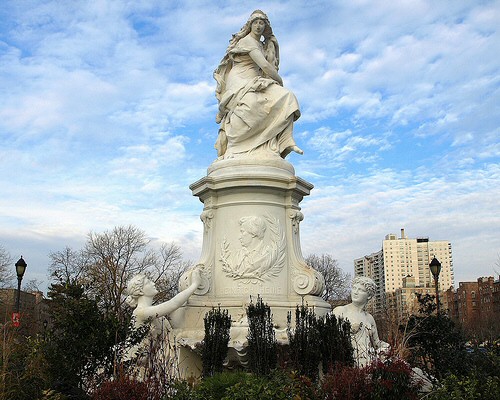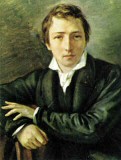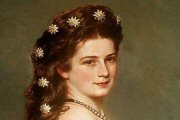![]()
(shortened by Gerhard Eichinger)
The long history of a monument that Sisi wanted to dedicate to her favourite poet
The Joyce-Kilmer-Park, behind the Yankee Stadium in the South Bronx, is usually not on any sightseeing program of a New York visitor. And yet the
park offers a surprise of a special kind.
There is a Lorelei fountain dedicated to Heinrich Heine. This fountain was created from Tyrolean marble by Ernst Herter, the sculptor who also designed the Hermes in front of the
Hermes Villa in Vienna. The client was Empress Elisabeth both times.
Sisi and Heine
Sisi was, if not a gifted one, at least a possessed poetess. After she had to give up her passion for riding in the mid-eighties for health reasons, she turned completely to travelling and poetry. Emperor Franz Josef had a hunting villa built for her in Lainz, apart from the official refuges of the Habsburgs (in the Hofburg, Schönbrunn, Laxenburg and Hetzendorf).
Elisabeth was personally involved in the selection of these monuments. At the 1881 Academy Exhibition she had met the
then still unknown Berlin sculptor Ernst Herter (1846 - 1917), after she had become enthusiastic about his plaster model of the dying Achill. Elisabeth liked Herter's work so much
that she also commissioned him to create a colossal statue of Hermes, which was erected in front of the Lainzer Villa and founded her present name "Hermesvilla".
Nevertheless, Elisabeth was very rare in the Hermes Villa, much to the disappointment of her husband. As she expressed in her poems, she felt like a seagull flying around without a
fixed home. Her interests were limited to Greek and her poetry, in which she felt inspired by her "master" Heine. Again and again she pointed out that she got her inspiration
directly from his spirit; once the "Master" even appeared to her in person.
Only a few confidants knew of Elisabeth's poems. Their veneration of Heinrich Heine, however, was generally known. Elisabeth knew long passages of Heine by heart and was intensively occupied with the life of her "master". She collected Heine manuscripts and portraits. She visited Heine's old sister Charlotte von Embden in Hamburg and prayed at Heine's grave in Paris.
At a time when monuments were erected to many intellectual greats, the plan to erect a monument to one of her most famous sons, Heinrich Heine, also matured in Düsseldorf. On the occasion of Heine's 90th birthday, a committee was founded in Düsseldorf in 1887 under the leadership of the acting mayor Lindemann, which published calls for the erection of a Heine monument in several newspapers. A storm of pros and cons set in, for Heine was a controversial poet in Wilhelmine Germany. Above all, anti-Semitic and German national groups agitated against him with great commitment.
When the Düsseldorf Heine Committee approached Elisabeth with a request for support, Elisabeth was not aware of the intensity of the public debate. For Elisabeth it was only natural that Düsseldorf wanted to erect a monument to his greatest son, and she spontaneously agreed. She committed herself both financially (with 12,950 Reichsmark) and personally to the erection of a monument for her master in his native city.
Elisabeth's Ernst Herter, who was currently working on the statue of Hermes for the Lainzer Villa, was the enforcing artist. After everything seemed clear from the public side in Düsseldorf, Herter developed two sketches and presented them to Elisabeth for appraisal. One depicted the poet sitting on a pedestal, the other was a fountain with a Lorelei motif. Elisabeth opted for the postament design. Elisabeth's saying that she "wishes the whole Heine" and "does not want to be fobbed off with a compromise" has been handed down by Herter.
Fights in Düsseldorf
But the agitations against the Heine memorial had meanwhile reached such an extent that the German Minister of Culture felt compelled to take a stand on it. He said that if the Heine memorial was to be built in the form of a statue, he would have to take the numerous protests into account. No one could object to a Lorelei fountain, however. The general applause for the Lorelei motif at an exhibition of the designs in the Düsseldorf Kunsthalle confirmed this judgement.
Nothing would have stood in the way of the completion of the Heine monument in Düsseldorf. Instead of accepting this compromise solution, the Düsseldorf Heine Committee wished Herter to create another of Heine's designs in the form of busts. Immediately the just soothed storm of indignation against the monument was renewed. But in the meantime the city government also wanted to avoid another public dispute. Under the flimsy argument that the building permit had meanwhile expired, the plan to erect a monument to Heine was abandoned. The city government even demanded that Herter reimburse the payments he had made for his preparatory work, which he of course refused. Elisabeth, too, had long since had enough of the arguments in which she was personally attacked, as far as censorship permitted. She gave up her commitment to the Düsseldorf monument in 1889.
For Elisabeth, the erection of a Heine monument, much to the disappointment of many liberals who saw her as an ally against nationalist and anti-Semitic trends, had from the outset been a purely personal affair. Moreover, Herter's Lorelei design, which she had paid for herself, was only the second best solution for her. She wanted to have her master depicted in full size.
The poet on Corfu
Since the late eighties Elisabeth has been travelling a lot in Greece. In 1888 she told her husband that she regarded Greece as her future home. Franz Joseph was not very enthusiastic about this, but fulfilled his wife's wish and had an expensive private castle built in the style of Troy and Pompeii.
In her private castle, called Achilleion, Elisabeth could finally pay homage to her beloved master Heine without compromise. She examined various portraits of Heine and then invited his nephew Gustav Heine-Geldern to determine which portrait was most similar to Heine. She finally decided on a design by the Danish sculptor Hasselriis. Heine's life-size figure, which resembled Herther's first design for Düsseldorf, was set up in a small temple in the garden of the Achilleion.
But this Heine monument, like the Lorelei fountain, was also to have an eventful future. After Elisabeth's death in 1898, her eldest daughter Gisela inherited the Achilleion. She sold the uncomfortable castle to the Imperial Family Fund, which sold it on to Wilhelm II in 1907. His first act as the new landlord was to have the Heine monument removed. This calculated gesture promptly earned him the enthusiastic applause of the German Boulevard. After several detours, Hasselriis' Heine monument finally reached France in the Jardin de Mourillon in Toulon, where it still stands today.

Heine Monument in the Jardin de Mourillon in Toulon
But back to Düsseldorf. The model of the Lorelei fountain, which had received so much applause at the Düsseldorf exhibition, was included in the Great Academic Exhibition in Berlin and published in several specialist journals, including international ones. Thus the people of Arion, a German association in New York, became aware of Herter's design. In 1895 they asked the artist whether he would be willing to build Heine's Lorelei fountain in New York. Herter happily agreed. After he had already done all the preparatory work, the work progressed rapidly. But there were also initial difficulties with the erection of the monument in New York. Originally, the Arion Association wanted to erect the Heine monument at a central location in Manhattan. First they had thought of the Columbus Circle, then of Central Park, but both places were not approved by the New York City Council.
Poetry without a head
For the New Yorkers, Heine was not such a controversial figure as for the Düsseldorfers, but a German Jew who had spent his entire life in Europe was not necessarily given a prominent place in Manhattan. Finally, the city council approved a square in a beautiful park in the Bronx. This place was a bit remote at that time, but a nice residential area, where Mark Twain was also at home.
On 8 July 1899 the unveiling of the monument took place, to which Herter travelled from Germany. According to his diary, the unveiling was an impressive manifestation of Germanism in America, with flags, parades and music bands. But the controversies surrounding this Heine monument continued even after the unveiling in New York. While in Germany it was only anti-Semitic Germans who agitated against Heine, in New York it was not only anti-Semites who perished at his monument. Especially during the two world wars, anti-German acts of vandalism repeatedly occurred against Heine as one of the most famous German poets.
Half a year after its unveiling, on 29 January 1900, the monument was devastated for the first time: The head of the personification of the poetry was cut off.
However, the damage to the monument continued. The personification of satire got a completely new head in the sixties, which was soon missing again. After the end of the Second World War, the anti-German acts of vandalism clearly declined, but at the same time the South Bronx experienced a general social decline. Anti-Semitic or anti-German acts of destruction were replaced by apolitical acts of vandalism by the local youth.
One last move
For a few years now, New York City Council has been trying to revitalize the shabbey South Bronx, and indeed violent crime and acts of vandalism have recently declined.
The Heine memorial has not been covered with graffiti lately. Nevertheless, the general condition was very poor and the heads of the well, which mostly did not function, were
missing. Only Lorelei herself, who combs her hair at the top of the monument, has been largely spared from devastation due to its inaccessible location.
But because this story is at least partly an American fairy tale, there is now a happy ending. Early this year, New York Mayor Rudolph Giuliani and the Borough President of the
Bronx, Fernando Ferrer, set up a community fund to renovate the Heine memorial, which grew to an impressive $1.2 million.
With this money, the Heine monument could be sent back on its travels. It was brought to Canada for restoration work in October. At the same time, the south side of the Joyce-Kilmer-Park was redesigned where the Lorelei fountain has been located since October 1999.

Lorelei Monument in the Joyce-Kilmer-Park in New York
Der article was published by the "Wiener Zeitung"
 Heinrich
Heine, last poet of romanticism,
Heinrich
Heine, last poet of romanticism,
* 13. December 1797 as Harry Heine in Düsseldorf; † 17. February 1856 in Paris
